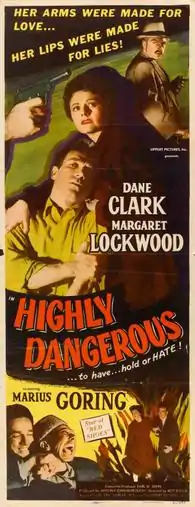Highly Dangerous
Highly Dangerous is a 1950 British spy film starring Margaret Lockwood. The screenplay was written by Eric Ambler.
| Highly Dangerous | |
|---|---|
 | |
| Directed by | Roy Ward Baker (as Roy Baker) |
| Produced by | Antony Darnborough executive Earl St. John |
| Written by | Eric Ambler |
| Starring | Margaret Lockwood Dane Clark Marius Goring Naunton Wayne |
| Music by | Richard Addinsell |
| Cinematography | Reginald H. Wyer |
| Edited by | Alfred Roome |
Production company | |
| Distributed by | General Film Distributors (UK) Lippert Pictures (US) |
Release date | 6 December 1950 (London) 12 October 1951 (US) |
Running time | 88-90 minutes |
| Country | United Kingdom |
| Language | English |
It was released in the US by Lippert Pictures as Time Running Out.
Plot
Frances Gray is as a British entomologist trying to stop a biological attack with the help of an American journalist.[1]
Cast
- Margaret Lockwood as Frances Gray
- Dane Clark as Bill Casey
- Marius Goring as Commandant Anton Razinski
- Naunton Wayne as Mr. Hedgerley
- Wilfrid Hyde-White as Mr. Luke (as Wilfrid Hyde White)
- Eugene Deckers as Alf
- Olaf Pooley as Detective-Interrogator
- Gladys Henson as Attendant
- Paul Hardtmuth as Priest
- Michael Hordern as Lab Director Owens
- George Benson as Sandwich Stand Customer
- Eric Pohlmann as Joe
- Joan Haythorne as Judy
- Patric Doonan as Customs Man
- Anthony Newley as Operator
- Anton Diffring as Officer At Station Checkpoint (uncredited)
Production
Margaret Lockwood had not made a film in 18 months following Madness of the Heart, focusing on stage work.[2] Earl St. John wanted a comeback vehicle and commissioned Eric Ambler to write her a film specifically as a vehicle for Lockwood. Although he had recently specialised in melodramas, Highly Dangerous was a comedy thriller in the vein of Lockwood's earlier hits, The Lady Vanishes and Night Train to Munich.[3] It was directed by Roy Ward Baker, who had served with Ambler during the war.[4]
"One thing about Eric is that he presents you with a script that is beautifully finished in every detail", said Baker.[5]
"I think Margaret Lockwood wanted to play a modern woman", recalled Baker. "It was actually Eric Ambler's first or second book, although the book had a different title and its main character was a man; Eric changed it to a woman to make it more interesting."[6]
The filmmakers wanted a Hollywood leading man to play opposite Lockwood. Wendell Corey was originally sought[7] before the role was given to Dane Clark, who had recently left Warner Bros. Filming started in June 1950 and took place at Pinewood Studios.[8]
Reception
Baker later said that "Highly Dangerous wasn't a very successful picture.... It was a good idea although I don't think I did it very well."[9]
Filmink said "it should have been Lady Vanishes-like but the film never gets its tone right. It starts off straight then goes a bit wacky and is just not fun – it lacks comic relief, and Lockwood seems old and tired."[10]
References
- "BRITISH THRILLER". The Australian Women's Weekly. 19 (4). Australia. 27 June 1951. p. 29. Retrieved 1 October 2017 – via National Library of Australia.
- "Maggie comes back in Highly Dangerous". The Sunday Times. Perth. 7 May 1950. p. 10 Supplement: Sunday Times MAGAZINE. Retrieved 31 October 2015 – via National Library of Australia.
- "Ambler writes a thriller-comedy". Times Pictorial. Dublin, Ireland. 15 April 1950. p. 13.
- STEPHEN WATTS (20 May 1951). "SUCCESS IN THE SHADOW OF FAILURE: Roy Baker Makes Mark as Director at Scene of Faded British Hopes On His Own Quick Return Army Training". New York Times. p. X5.
- McFarlane p 49
- McFarlane p 50
- "IN THE FILM SPOTLIGHT". The Mirror. 27 (1457). Western Australia. 22 April 1950. p. 16. Retrieved 10 April 2016 – via National Library of Australia.
- "JUST VERY, VERY, DEAR FRIENDS". The Mirror. 27 (1463). Western Australia. 3 June 1950. p. 15. Retrieved 10 April 2016 – via National Library of Australia.
- McFarlane p 49-50
- Vagg, Stephen (January 29, 2020). "Why Stars Stop Being Stars: Margaret Lockwood". Filmink.
- McFarlane, Brian, An Autobiography of British Cinema, 1997
External links
- Highly Dangerous at IMDb
- Highly Dangerous at TCMDB
- Highly Dangerous at Britmovie
- Highly Dangerous at AllMovie
- Film4 review
- Review of film at Variety